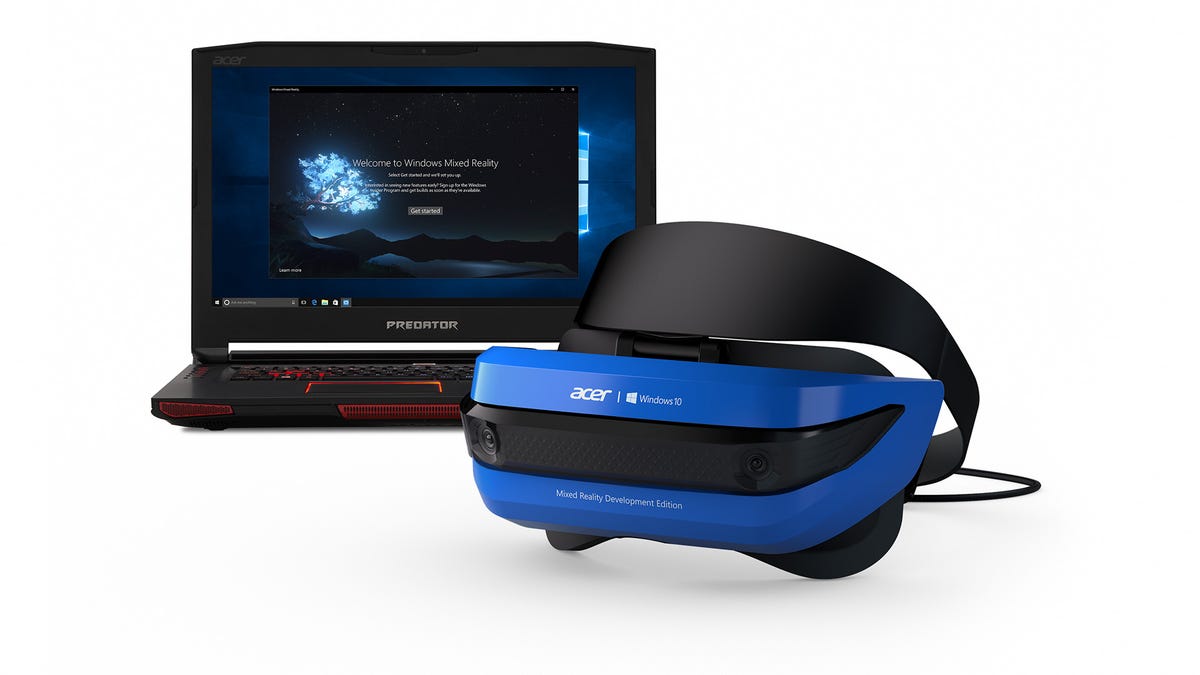Microsoft's new VR headset could bridge HoloLens, Windows and Xbox (hands-on)
Acer may be the first to start shipping an inexpensive, quality headset for Windows developers -- but this $300 device is no HoloLens.
Microsoft doesn't have its own VR headset. It has five -- last year, Acer, Asus, Dell, HP and Lenovo all signed on to make wearable screens for Windows PCs.
There's just one thing: Microsoft insists that these five devices aren't virtual reality headsets. They're "mixed reality."
This week, as Acer starts shipping the first developer-oriented headset, we're finally coming to a full understanding of what that actually means.
During the 2017 Game Developers Conference here in San Francisco, we got an early hands-on look at what it's like to use Windows on a headset that isn't built for games, and spoke to Microsoft HoloLens team leader Alex Kipman about the vision behind these new headsets. (Hint: Xbox is a big part.)
Mixed reality = cameras and tracking?
Microsoft's idea of mixed reality is an umbrella covering practically everything from augmented to virtual reality. And that's the way it should be, according to Kipman. "What happens when your VR headset of tomorrow has the ability to see the real world and put holograms on it? The proper term is mixed reality."
But these new more affordable Windows mixed reality headsets, like Acer's, don't see the real world quite the way you'd expect. Unlike Microsoft's HoloLens, these devices aren't cordless and don't have see-through visors. They're opaque, like VR headsets, and tether to a Windows PC, or come 2018, an Xbox One or Project Scorpio game console, with a long cord. They cost about $300 (roughly £250 or AU$400 converted).
Because they have cameras and "six degrees of freedom" tracking to work without external sensors or markers, like the HoloLens, Microsoft wants you to see them as something special. But many upcoming VR headsets might also have those capabilities.
As Kipman admits, by his own definition of mixed reality, the Oculus Rift and HTC Vive are capable of mixed reality, too. He's referring to taking real-life scanned items and putting them in VR, versus taking virtual things and floating them in the everyday world (AR).
But as Microsoft's own demo showed us this week, an opaque, VR-style headset can make a lot more sense for a lot more software as of today. Where the company's HoloLens developer kit has a narrow field of view that makes it tough to see even an entire application window at once, much less an entire Windows desktop, that wasn't a problem with Microsoft's VR-style rig. The new headsets will work with HoloLens apps, display Windows Universal Apps, even launch traditional Win32 programs in a single "desktop" window -- and the wider field of view means there's no hunting around the room to find each one.
What we didn't see in the opaque headset demo yet: the HoloLens-like ability to place those windows (and virtual 3D objects) onto digital representations of the real world.
Microsoft's new headsets aim to share the same software as HoloLens, but without being see-through.
With the HoloLens, the headset would map out your room in real time, so you could "pin" windows and objects to surfaces in the real world -- and have them stay in place. The opaque headset let us pin them, but only onto a generic virtual world, not a recreation of our actual room -- which might also be the reason we kept bumping into unseen walls. (We understand Microsoft will add the ability to map out such boundaries, though.)
Microsoft's dev kits are targeted at game developers, because to Microsoft that's exactly what these headsets are for. "HoloLens is focused on task workers and enterprise. The affordable headsets starting at $299 are entirely focused on gaming and entertainment," says Kipman. But the apps aren't here yet. For everyday gamers, Vive and Oculus Rift are full of apps that Microsoft's mixed reality headsets won't necessarily be able to access. Microsoft's building a different ecosystem for these, built on what HoloLens already supports.
In the meanwhile, as we saw firsthand, users will already be able to stream existing, flatscreen Xbox One games to the headset and play them in their own personal theater.
Xbox and future controllers are coming
The headset we tried briefly has a few key features: dual 1,440x1,440-pixel resolution displays refreshing 90 times per second for smooth motion, a flip-up visor (which Kipman says is "clever design," but "not a requirement"), a single cable combining HDMI and USB 3.0, and a standard 3.5mm headset jack.
While the prototype wasn't nearly as comfortable, it looks a bit like a PlayStation VR. Maybe that analogy isn't bad, because next year Microsoft plans on connecting mixed reality to its Xbox platform. Both the Xbox One and Scorpio will be compatible. In that sense, Microsoft might be skipping a half-generation for console VR.
Kipman says, "We're going to bet on a universal platform that can go from X86 to ARM. Mixed reality experiences that go from HoloLens to PCs. Xbox is no different. It's the same universal platform." Will there be future controllers? "Short answer: yes," says Kipman, but he wasn't ready to reveal anything more. In our demo, we mostly used a Bluetooth-ready Xbox One gamepad to move and teleport through the VR environment, with a keyboard and mouse as backup; if the room is large enough, you can just freely walk around.
Microsoft's mixed-reality headsets aren't necessarily like the HoloLens. But for now, they'll be the closest thing PC gamers will be able to easily buy. Unless, of course, Oculus or Valve launch similar products down the road.
Microsoft wants its headsets to be interchangeable. Kipman sees the various headsets like monitors: resolution might differ, but any one will work. But, will Microsoft's vision of headsets mesh with Valve's SteamVR and Facebook's plans for Oculus? That's still not clear. And it may not be for a while.




